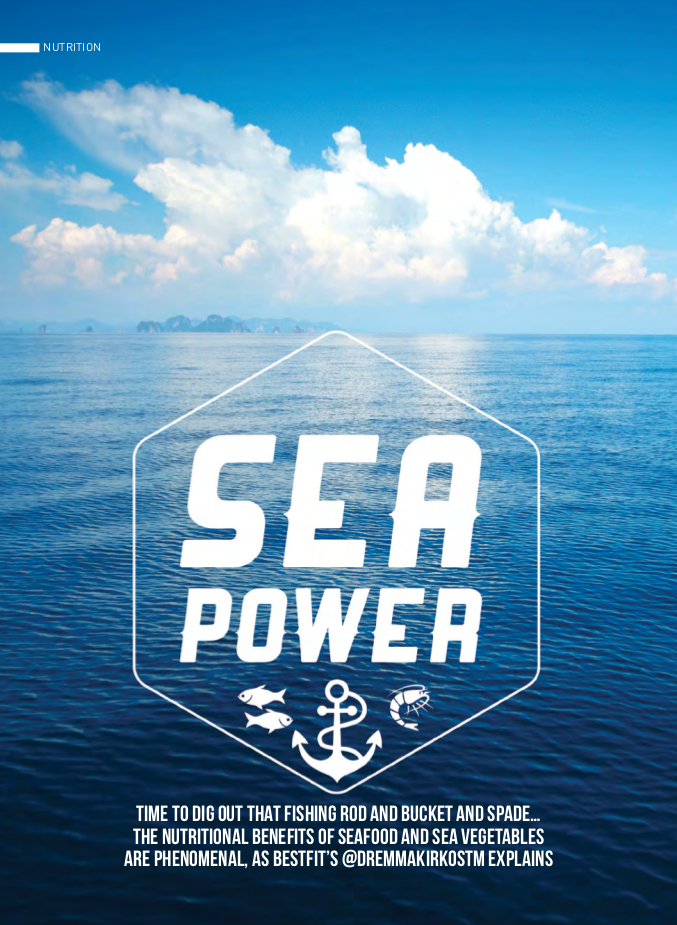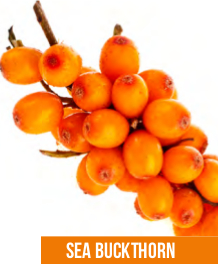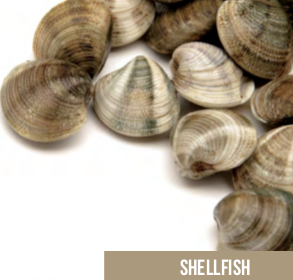BESTFIT Issue 20 – Sea Power
Share

No doubt you are well versed with the benefits of salmon consumption. some of us are even up to speed when it comes to the advantages of mackerel (see end of this article), but seafood is often an untapped resource at our disposal, which is surprising given the potential to provide an abundance of nutritional benefits.
 The fact is that some of the most nutrient-dense food items are edible plants, marine algae, fish and shellfish. Utilised for centuries but neglected and overlooked more recently, these glorious nutritional treasures are returning to our tables, packed with a powerful punch of organic goodness we would be foolish to overlook again.
The fact is that some of the most nutrient-dense food items are edible plants, marine algae, fish and shellfish. Utilised for centuries but neglected and overlooked more recently, these glorious nutritional treasures are returning to our tables, packed with a powerful punch of organic goodness we would be foolish to overlook again.
Sea vegetables are commonly used in Japanese, Chinese and Thai cuisine on a daily basis, but suggest to a Brit that they add a seaweed garnish to their pie and chips and the reception would probably be negative. Think again, though, as those sea vegetables have more minerals than any other foods and have been linked with having anti-fungal, antiviral and antibacterial properties. A thickening agent called Algin has been shown to bind to heavy metals and toxins in the body aiding to rid them safely whilst soothing the digestive tract. More commonly linked with assisting with thyroid health and parathyroid stimulus due to the high levels of iodine, the absorption of calcium and the nourishing of bones and joints means it may also be excellent for arthritis sufferers. So in short, do not overlook these lettuces of the sea.
 Are you a berry fan? Do you love adding high levels of antioxidants to your smoothies and breakfast bowls? Well, searching in the bushes found in the sand dunes of our coasts could yield an unexpected delight. The sea buckthorn is a tart orange-yellow berry containing 200+ bioactive compounds and omega seven fatty acids, which are very rarely found in plant life in the UK. There are several research projects looking into the effect on skin and mucous membranes and how the content of these berries may help protect against things such as toxins, stress, ageing and drugs. The high level of flavonoids could benefit cardiovascular health and assist with reducing cholesterol levels. There is a possibility that using this berry during chemotherapy may help to protect you against the side effects of the drugs, too. You will find them between July and September, but you can pick them and freeze them for antioxidant protection all year round.
Are you a berry fan? Do you love adding high levels of antioxidants to your smoothies and breakfast bowls? Well, searching in the bushes found in the sand dunes of our coasts could yield an unexpected delight. The sea buckthorn is a tart orange-yellow berry containing 200+ bioactive compounds and omega seven fatty acids, which are very rarely found in plant life in the UK. There are several research projects looking into the effect on skin and mucous membranes and how the content of these berries may help protect against things such as toxins, stress, ageing and drugs. The high level of flavonoids could benefit cardiovascular health and assist with reducing cholesterol levels. There is a possibility that using this berry during chemotherapy may help to protect you against the side effects of the drugs, too. You will find them between July and September, but you can pick them and freeze them for antioxidant protection all year round.
Samphire is another to add to your armoury. It is sometimes called wild sea asparagus and can be found in salt marshes and mud flats. Again, like the sea buckthorn, it’s in season between July and September. It is renowned for its digestive benefits and may also be anti-flatulent. Even as far back as the 17th century, there were surgeons writing about the use of this vegetable in the treatment of digestive ailments and obstructions due to its diuretic and depurative properties. Like seaweed, it is a strong source of iodine and is also packed with phytochemicals, vitamins A, C, B2, B15, AA’s, minerals, iron, calcium, zinc, manganese and vitamin D. Sailors used to take it along on their voyages to help prevent scurvy. I love it cooked in a little coconut oil in a wok with a little garlic and chilli served with a fillet of sea bass.
“Shellfish are probably one of the most avoided food products due to a fear of food poisoning. however, and ironically, one of the most common sources of poisoning is pre-cooked rice”
 Shellfish are probably one of the most avoided food products due to a fear of food poisoning. However, and ironically, one of the most common sources of poisoning is pre-cooked rice, a staple in most bodybuilders’ diet plans! Cholesterol and high allergy rates are also reasoned for avoidance based on myth. In fact, they can be a fabulous source of selenium, which is lacking in depleted soils, and oysters are a very well known source of zinc, which is fabulous for immune function, heart and nervous system alike. Muscles contain such large quantities of iron they are able to rival red meat for levels. Plus, they are handy to keep in the freezer, and they always look fabulous in any dish from curry to cocktail.
Shellfish are probably one of the most avoided food products due to a fear of food poisoning. However, and ironically, one of the most common sources of poisoning is pre-cooked rice, a staple in most bodybuilders’ diet plans! Cholesterol and high allergy rates are also reasoned for avoidance based on myth. In fact, they can be a fabulous source of selenium, which is lacking in depleted soils, and oysters are a very well known source of zinc, which is fabulous for immune function, heart and nervous system alike. Muscles contain such large quantities of iron they are able to rival red meat for levels. Plus, they are handy to keep in the freezer, and they always look fabulous in any dish from curry to cocktail.
Assuming you know the amazing nutritional value of salmon – it’s an excellent source of vitamin B12, vitamin D, selenium, niacin, omega-3 fatty acids, protein, phosphorus, vitamin B6, choline, pantothenic acid, biotin, and potassium – it is no surprise that you might not tap into alternative sources, such as Mackerel or sardines. However, these lesser consumed fish are strong sources of the omega-3 fatty acids, selenium and vitamin D, which helps the efficient functioning of the hormonal system and metabolic rate. They are also associated with being fantastic anti-inflammatory supplements and can be remarkably tasty. Don’t rule these out of your diet, they can be a very cost effective alternative to salmon and tuna.
Best get out that fishing rod…













FOLLOW BESTFIT